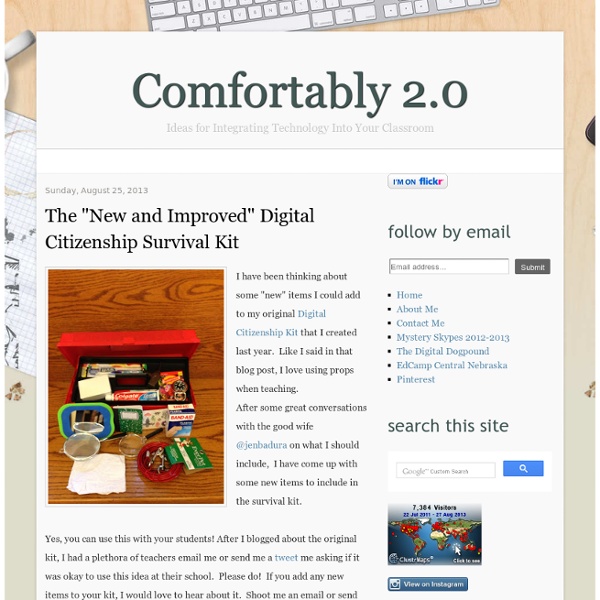Comfortably 2.0: The Digital Citizenship Survival Kit
It's a simple little prop I use when teaching Digital Citizenship to our K-8 #aurorahuskies students. I love utilizing props to try to get my point across to students. To me, it helps a student retain the lesson better. Let me introduce you to Mr. Badura's "Digital Citizenship Survival Kit." Each of the items has a purpose. Here are the items I have in my "Digital Citizenship Survival Kit" and what each item represents: Padlock The padlock is to remind students to set strong passwords and to set up passcode locks on all of their digital devices. Toothbrush I tell students to think that passwords and toothbrushes are very similar in the fact that you NEVER want to share passwords. Permanent Marker Everything that you put online is permanent....even if you hit the delete button after posting. Toothpaste Imagine the information that you are putting online is like the toothpaste coming out of the tube. The survival kit is very simple.
- Digital Footprint - Advice from the Experts at Tech Forum NY #TLTF14
0 Comments October 27, 2014 By: Lisa Nielsen Oct 26 Written by: 10/26/2014 1:23 PM ShareThis If students want to run for office, run a business, or change how things are run where they live, work, or play, they need to be savvy users of social media. Below is their advice. How can you ensure your students are well Googled by the time they graduate? Common Sense Media lessons. Explain the importance of professional development. Professional Development and teacher buy in is the key! What’s your advice for others who want to begin creating their own positive digital footprint? Begin looking at the online identity of others. Additional Resources: The experts: Jackie Patanio, Technology Coach, PS 16, The John J Driscoll School Darlynn Alfalfa, Teacher/Tech Coordinator, MS 167, Robert F. Disclaimer: The information shared here is strictly that of the author and does not reflect the opinions or endorsement of her employer.
Webonauts Internet Academy
Come play again later! Come play again tomorrow!
Welcome to the Web
Thank you for visiting 'Welcome to the Web'. By working your way through this web site and taking part in the exciting challenges and activities, you will learn all about the Internet. Good luck! Choose a section to begin. If you have never used Welcome to the Web before, it's important to start at 'The Beginning'! This website is part of Teaching Ideas - Please send feedback to mark@teachingideas.co.uk Thank you to the following people for their support and contributions to this site: Gareth Pitchford - for his help with the original site and for activity suggestions. Read our Privacy Policy, Terms of Use and Cookie Information
10 Great Digital Citizenship Lessons from Google
July 15, 2014 Today I want to draw your attention to these excellent resources from Google. These are 10 interactive lessons designed by the folks in Google to help students learn more about different themes related to the general topic of digital citizenship. And while all these lessons revolve around YouTube, most of the principles they include could also be projected on any other digital platform. Using these lessons, teachers and students will be able to gain useful skills and a holistic understanding about responsible digital citizenship, not only on YouTube, but in all online activity. Below is a list of lessons, and the recommended flow for delivery. 1- What Makes YouTube Unique What Makes YouTube Unique - basic facts and figures (40 minutes) - Teacher’s Guide, Slides Lesson objective: Understand the environment and scale of YouTube 2- Detecting Lies Detecting Lies - (35 minutes) - Teacher’s Guide, Slides 4- Online Reputation and Cyberbullying 7- Privacy
Sexting And Cyberbullying in Schools
When students have access to mobile devices in school, either in a 1:1 or BYOD environment, much of what happens in their school lives cross over into their personal lives. Here at Eanes ISD, over 80% of our secondary students have smartphones that they bring with them to school on top of the school-issued iPad they are given. While we have some say about the activity on the school device, students’ use of their phones for inappropriate activity is an issue both in and out of school. Last year, I wrote this post about the app YikYak and this one about Secret photo-sharing apps. I wrote these (and accompanying letter to district parents) not to scare adults into taking away kids’ phones, but instead to spark a conversation between child and parent. Today, I sent home the following letter about sexting and cyberbullying via a couple of different apps that we’ve become privy to here. Parents of Secondary Students, Sexting Cyberbullying via apps like Brighten and After School
Video: I Dared Two Elite Hackers to Ruin My Life
This is Episode 8 of Real Future, Fusion’s documentary series about technology and society. More episodes available at realfuture.tv. Several months ago, while I was typing a few e-mails at my dining room table, my laptop spoke to me. “You…look…bored,” it said in a robotic monotone, out of nowhere. Startled, I checked my browser tabs and my list of open applications to see if anything had been making noise. Then I realized: this was the hacker. Hence the robot voice. I had to admit, it was a pretty good troll. Last year, after reporting on the hacks of Sony Pictures, JPMorgan Chase, Ashley Madison, and other major companies, I got curious about what it felt like to be on the victim’s side of a data breach, in a time when so much of our lives is contained in these giant, fragile online containers. Fortune 500 companies do this kind of thing all the time. I’m not a Fortune 500 company, but I still wanted to subject myself to a personal penetration test to see how my security measured up.



